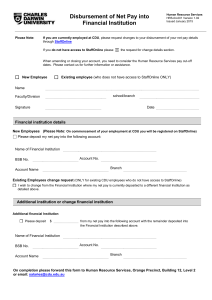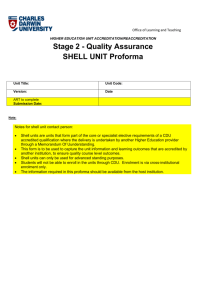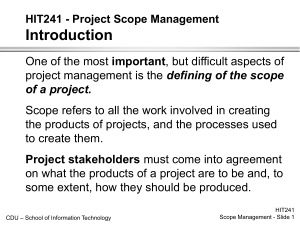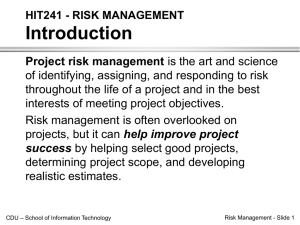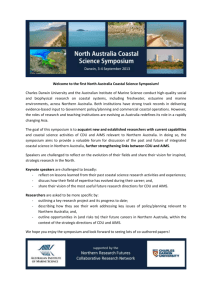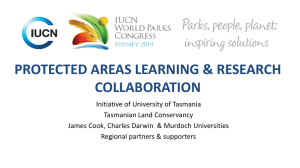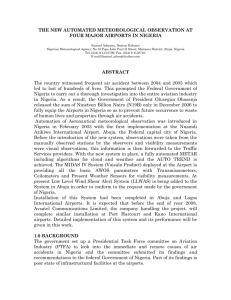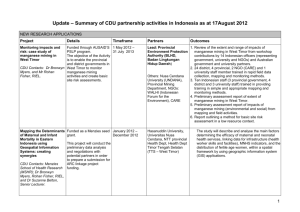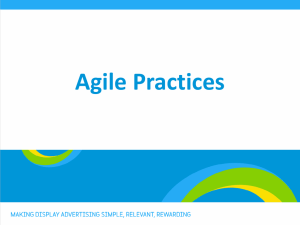ADRI PowerPoint presentation
advertisement
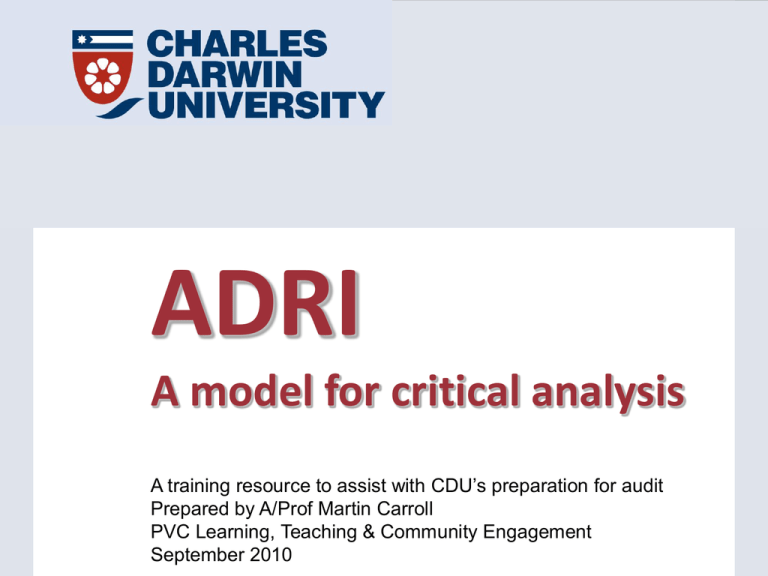
ADRI A model for critical analysis A training resource to assist with CDU’s preparation for audit Prepared by A/Prof Martin Carroll PVC Learning, Teaching & Community Engagement September 2010 Overarching Principle CDU will be proactive and transparent in its approach to audit. This is an opportunity to support our ongoing quality improvement efforts. What is a Quality Audit? A public and systematic determination of whether: • CDU’s goals and objectives are based on appropriate regulations, standards (note Appendix E) and benchmarks; • CDU’s planned arrangements are suitable to achieve those goals (i.e. the overall approach); • CDU’s actual practice conforms to the planned arrangements (i.e. the deployment); • The arrangements achieve the desired results; • CDU is learning from a self-evaluation of its approach, deployment and results, and can demonstrate improvements. What is a Quality Audit? A public and systematic determination of whether: • CDU’s goals and objectives are based on appropriate regulations, standards (note Appendix E) and benchmarks; • CDU’s planned arrangements are suitable to achieve those goals (i.e. the overall approach); • CDU’s actual practice conforms to the planned arrangements (i.e. the deployment); • The arrangements achieve the desired results; • CDU is learning from a self-evaluation of its approach, deployment and results, and can demonstrate improvements. Quality Reviewing AuditGraduate ‘Double Loop’ Destinations Process ADRI Cycle of Quality Assurance Evidence examples: • Internal program review reports • Input obtained from industry & professional bodies • Resulting action plans • Reports on progress against action plans Evidence examples: • Graduate destination statistics • Evidence of employer satisfaction (e.g. survey results) Topic: Evidence examples: • Uni graduate destination targets • Industry needs analysis • Careers Service Plans • Curriculum demonstrating links to industry needs Graduate Destinations Evidence examples: • Interviews with academic staff, careers service staff, recent graduates and employers Internal Reviewof the System (results a Portfolio section with OFI) It ADRI can is be aapplied model toof quality any topic assurance – in inthis used example, by agencies theStrengths analysis in& many of a Externalcountries Review of thearound Systemgraduate (results Audit Report with Coms, Affs, Recs) university’s the in world destinations (e.g.section AUQA) Key Point Each aspect of ADRI involves consideration of different types of evidence. Only the totality makes sense when analysing the big picture. I A Approach R D What CDU proposes to achieve • Statements of intent (goals, objective etc.) will be found in multiple sources: – applicable Legislation – Strategic Plan 2010-2014 and internal plans – Bylaws, policies, procedures, guidelines – Cycle 1 Audit Report – MCEETYA National Protocols – An unpacking of the Themes – External standards I A Approach R D What CDU proposes to achieve • Internal and external statements of intent must align. • The processes for setting statements of intent require evidence of appropriate benchmarking and stakeholder involvement (this is AUQA’s proxy for “Fitness of Purpose” auditing). I A Approach R D How CDU proposes to achieve its purpose • Operational Plans – detailing what should be done by when, by whom, to what standard and with what resources. • Manuals – detailing how processes should be implemented. • Professional development and training aligned to the University’s operational needs. • Alignment of resource allocation to plans. I A Approach R D Broad Questions • What external requirements apply to CDU? How are they incorporated into the Strategic Plan? • Does CDU have set of goals, objectives, strategies and targets that are clearly understood by the governing bodies and staff? • Was there appropriate consultation, benchmarking and analysis in developing the Strategic Plan? • What standards and external benchmarks have been applied? I A Approach R D Broad Questions (cont.) • Does the planning process incorporate appropriate risk management? • Does everyone know what they are supposed to be doing, how and why? • Are goals well supported with plans, manuals and training? • Are there clear means for monitoring progress against the goals? I A Approach R D Cautions • An assessment of Approach, on its own, does not tell the whole story – only what is intended. • Need to look at a wide range of sources to get the full Approach. • Alignment of various goals and strategies ought to be by design, not accident. • Equally, alignment of plans with resource allocation models ought to be by design. I A Deployment R D Deployment Dimensions • Also known as ‘implementation’ or ‘process’. • Looks at how CDU is implementing its approach. • In other words, do the plans and bylaws happen in reality? • This is best tested through interviews; tap into people’s ‘lived experiences’. • Also includes consideration of input factors such as the quality of resources. I A Deployment R D Broad Questions • What do people do? • How do they know if they are doing a good job? • Do all staff have the necessary authority and resources to deliver what is expected of them? • Do they have the necessary skills and knowledge? • Is the organisational structure a help or a hindrance to deployment? I A Deployment R D Broad Questions • Are there appropriate indicators for monitoring the effectiveness and efficiency of processes? How are these reported and used? • Are there appropriate means for intervening if necessary? How well do they work? • Where the approach is deliberately not being followed, why not? How are changes to the planned processes managed? • Are people allowed to contribute ideas? I A Deployment R D Cautions • It is insufficient to only focus on deployment. It must relate to an approach and lead to results. • It is essential to ‘triangulate’ anecdotal evidence about deployment (e.g. from interviews) with other sources of information, until the issue is ‘saturated’. TRIANGULATE! Corroborate information by obtaining original evidence from more than one type of source Information Source A Topic Information Source B Information Source C SATURATE! Keep collecting evidence until nothing new of significance emerges I A Results R D Results Dimensions • Quality cannot be assured by only focusing on the goals, plans, inputs and processes. • There must be an emphasis on what is actually achieved – the results! • Every intent must have at least one reported result. • Every result should link back to a statement of intent. I A Results R D Results Dimensions • It is essential that a causal relationship can be shown between the approach, the deployment and the eventual result. Otherwise the result may be just chance. • If you know that A+B+C = 19 you still do not know what B is (i.e. whether each step in the process is adding value or not). 7 + (-6) C = 19 A B + 18 I A Results R D Results Dimensions • Results will be both quantitative and qualitative. • In order to be meaningfully interpreted, results ought to be expressed as trends over 3-5 years, with targets and benchmarks. • Results for many goals will be aggregated from the results of its component objectives. • Examples of good practices in reporting results follow... PERFORMANCE MEASURES (Ensure that the measurement scale is fully understood!) Performance Measure With result, trend, targets, benchmark averages & best practices Actual Results 2006 Targeted Results Peer Average Upper and Lower Quartiles 2007 2008 2009 2010 Annual Result for Goal #1 2011 PERFORMANCE MEASURES One qualitative + quantitative approach A Low awareness of issue. Ad hoc plans. Random training. Commitment attained. Planning framework. Training available. D Ad hoc practices. Not linked to plans. Not monitored. Numerous good practices. Practice aligns with plans. Processes are analysed. R I Results not linked to plans. Most plans have results. Results not measured. Most results reported. Where measured, variable. Most targets achieved. Staff input limited. Review processes limited. Improvements are random. Staff input allowed. Review framework. OFI and GP identified. Systematic approach. Leading-edge vision. Full set of plans. Plans aligned & integrated. Training linked to plans. Training comprehensive. Good practice systemic. Plans inform practice. Monitoring in place. Processes benchmarked. Practice informs plans. Good practices promoted. All plans have results. All results reported. Targets achieved. Stretch targets established. Results are analysed. Targets exceeded. Staff input encouraged. Staff directly empowered. Reviews systematic. Self-reviews effective. Benchmarking undertaken. Benchmark host. Annual Result for Goal #1 I A Results R D Broad Questions • For each statement of intent, what are the results? • Does CDU know exactly how and why those results were achieved? • Have these results been appropriately contextualised (e.g. using targets, trends and benchmarks)? • What meaning/interpretation does CDU derive from the results? I A Results R D Cautions • It is insufficient to only consider results. • Results only make sense in the context of the approach and deployment. • The manner in which a result is presented can influence how it is interpreted, so adopt an attitude of ‘healthy skepticism’. That is what the Auditors are trained to do. I A Improvement R D Improvement Dimensions • This dimension looks at what CDU knows about itself in order to get better and better. • Intentions should be regularly recalibrated. • Processes should get more efficient and more effective over time. • Results should indicate increasing success. • This requires a comprehensive system of review – not just consideration of results. I A Improvement R D Broad Questions • What data about CDU performance is routinely collected and reported? How is the validity of the data ensured? What happens to the data? • How is the Strategic Plan (and other plans) reviewed and revised? • What review processes are in place for CDU’s major activities? How does CDU know that the review processes are effective? I A Improvement R D Broad Questions (cont.) • Is the process of self review, learning and improvement endemic throughout the organisation? • Are all staff empowered and encouraged to contribute to ongoing improvement efforts? • What has changed/improved as a result of the review processes? • What does CDU intend to change/ improve as a result of the review processes? I A Improvement R D Cautions • If not driven by sound values, this aspect of ADRI can be very threatening and disempowering for staff (who may feel that their jobs are in jeopardy) and students (who may feel that their grades are in jeopardy). • Findings from surveys and reviews are often not used effectively. • ‘Wet Paint’ syndrome. This is fine – if it leads to improvements. Key Point It is ok to use the audit to catalyse improvements. In fact, it is desirable as evidence of quality improvement in action. But new improvements must be reported as such, and set in an ongoing context. I A Improvement R D Cautions ADRI Tips • This is the overarching method of self review used for AUQA audits – by auditees and by auditors. • For any given topic, at any point in time, CDU will be strong in some aspects of ADRI and less strong in others. This is normal. A quality audit looks for evidence of the quality improvement cycle in action. • ADRI can be applied at macro and micro levels, but for audit purposes it is best applied at the subsection (specific topic) level. Analysis vs. Problem Solving • ADRI is a method for analysing a total QA system. It can be used internally or externally. It can identify strengths as well as opportunities for improvement (OFI). • ADRI is not a planning framework, although it provides useful information for planning. • ADRI does not identify the best solution to an OFI. To do so would require problem-solving methods (such as benchmarking). • Therefore, AUQA recommendations arising from ADRI ought to focus on what needs to be improved, not how it needs to be improved. Reviewing & improving Approach, Deployment & Results Mission. Planning, designing processes and training staff Analysing measures of outcomes against goals Implementing plans and monitoring processes For further information: www.cdu.edu.au/audit2011 Martin Carroll, PVC Learning, Teaching & Community Engagement Tel: 8946 6333 Fax: 8946 6199 Email: martin.carroll@cdu.edu.au Sinead Vincent, Project Support Officer Tel: 8946 7206 Fax: 8946 6928 Email: audit2010@cdu.edu.au
